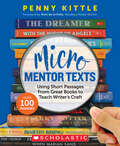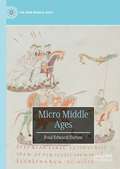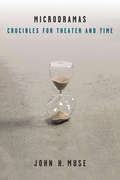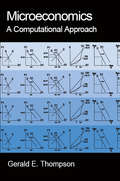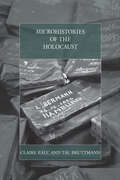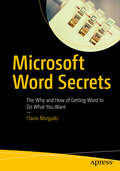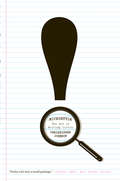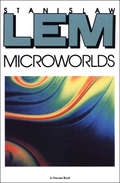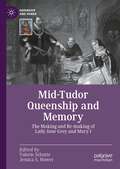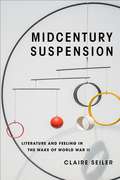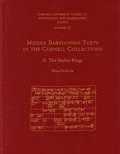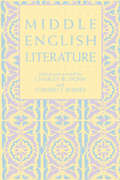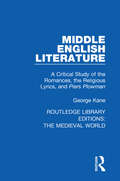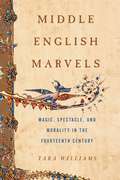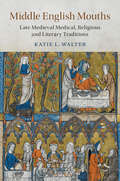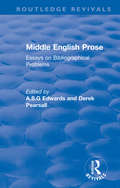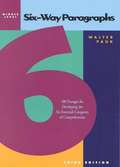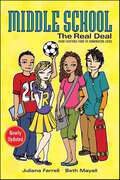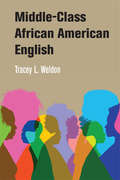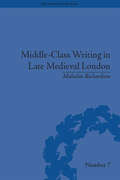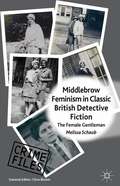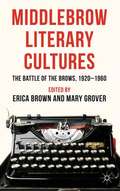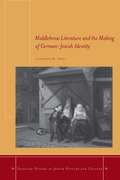- Table View
- List View
Micro Mentor Texts: Using Short Passages From Great Books To Teach Writer's Craft
by Penny KittleAt a time when students' attention is being pulled in many directions, writing expert Penny Kittle shows us the power of helping them to focus in and communicate clearly. She does that through the study of "micro mentor texts," excerpts from acclaimed books, and the decisions authors make to craft those texts so they deeply engage readers. Her book includes dozens of short texts and mini-lessons based on them--as well as many practice opportunities for students and demonstration videos for you.
Micro Middle Ages (The New Middle Ages)
by Paul Edward DuttonMicro Middle Ages brings together five microhistorical case studies focusing on small or seemingly inconsequential evidence that leads to broader conclusions about medieval history and the way we do and understand history in general. Paul Dutton provides an overview of microhistorical approaches and theorizes about its use in pre-modern history. As opposed to studying history “from above” or history “from below,” Dutton shows the advantages for historians of doing history “from the inside out,” starting from some single, overlooked, but potentially knowable thing, delving deep inside, and then reattaching it to its time and place. Such an approach has one abiding advantage: its insistence on being grounded in the particularity of the evidence. The book highlights what the microhistorical is, its conceptual and practical challenges. Dutton argues that the attention to the micro has always been with us and is a constitutive, cognitive part of who we are as human beings.
Microdramas: Crucibles for Theater and Time
by John H. MuseIn Microdramas, John H. Muse argues that plays shorter than twenty minutes deserve sustained attention, and that brevity should be considered a distinct mode of theatrical practice. Focusing on artists for whom brevity became both a structural principle and a tool to investigate theater itself (August Strindberg, Maurice Maeterlinck, F. T. Marinetti, Samuel Beckett, Suzan-Lori Parks, and Caryl Churchill), the book explores four episodes in the history of very short theater, all characterized by the self-conscious embrace of brevity. The story moves from the birth of the modernist microdrama in French little theaters in the 1880s, to the explicit worship of speed in Italian Futurist synthetic theater, to Samuel Beckett’s often-misunderstood short plays, and finally to a range of contemporary playwrights whose long compilations of shorts offer a new take on momentary theater. Subjecting short plays to extended scrutiny upends assumptions about brief or minimal art, and about theatrical experience. The book shows that short performances often demand greater attention from audiences than plays that unfold more predictably. Microdramas put pressure on preconceptions about which aspects of theater might be fundamental and about what might qualify as an event. In the process, they suggest answers to crucial questions about time, spectatorship, and significance.
Microeconomics: A Computational Approach
by Gerald E. ThompsonThis concise and comprehensive introduction to economics offers readers at all levels a more realistic approach to understanding the elements of resource and product markets, including the role of business decisions; technological change; product differentiation; uncertainty; and the optimal location of activities. With the book's easy-to-use software package for computations, even non-economists will become strongly motivated and can gain a proficiency in economic analysis as well as in practical and professional decision-making skills. End-of-chapter problems, computer exercises, programming examples, and numerous diagrams further enhance the book's usefulness.
Microhistories of Composition
by Bruce McComiskeyWriting studies has been dominated throughout its history by grand narratives of the discipline, but in this volume Bruce McComiskey begins to explore microhistory as a way to understand, enrich, and complicate how the field relates to its past. Microhistory investigates the dialectical interaction of social history and cultural history, enabling historians to examine uncommon sites, objects, and agents of historical significance overlooked by social history and restricted to local effects by cultural history. This approach to historical scholarship is ideally suited for exploring the complexities of a discipline like composition. Through an introduction and eleven chapters, McComiskey and his contributors—including major figures in the historical research of writing studies, such as Louise Wetherbee Phelps, Kelly Ritter, and Neal Lerner—develop focused narratives of particular significant moments or themes in disciplinary history. They introduce microhistorical methodologies and illustrate their application and value for composition historians, contributing to the complexity and adding momentum to the emerging trend within writing studies toward a richer reading of the field’s past and future. Scholars and historians of both composition and rhetoric will appreciate the fresh perspectives on institutional and disciplinary histories and larger issues of rhetorical agency and engagement enacted in writing classrooms that are found in Microhistories of Composition. Other contributors include Cheryl E. Ball, Suzanne Bordelon, Jacob Craig, Matt Davis, Douglas Eyman, Brian Gogan, David Gold, Christine Martorana, Bruce McComiskey, Josh Mehler, Annie S. Mendenhall, Kendra Mitchell, Antony N. Ricks, David Stock, Kathleen Blake Yancey, Bret Zawilski, and James T. Zebroski.
Microhistories of the Holocaust (War and Genocide #24)
by Claire Zalc Tal BruttmannHow does scale affect our understanding of the Holocaust? In the vastness of its implementation and the sheer amount of death and suffering it produced, the genocide of Europe’s Jews presents special challenges for historians, who have responded with work ranging in scope from the world-historical to the intimate. In particular, recent scholarship has demonstrated a willingness to study the Holocaust at scales as focused as a single neighborhood, family, or perpetrator. This volume brings together an international cast of scholars to reflect on the ongoing microhistorical turn in Holocaust studies, assessing its historiographical pitfalls as well as the distinctive opportunities it affords researchers.
Microsoft Word Secrets
by Flavio MorgadoGet hints, useful tricks, and solutions to those annoying problems that plague users of Microsoft's ever-popular word processing software. This book goes beyond a how-to guide. You will understand where some of Word's odd behavior comes from, how underlying inheritance rules can affect your formatting, and how to understand and make use of the many hidden characters that Word uses to control the text. By the end of the book, you'll be able to fly through your Word processing without the usual headaches. What You'll Learn Understand why you should care about hidden characters, and how they can save you time and headaches Use templates effectively, and produce your own templates Employ fast desktop publishing techniques to produce a polished final document Generate a table of contents and index Fix those pesky tables forever! Who This Book Is For Everyone who uses Microsoft Word and has encountered difficulties and felt frustrated and slowed down
Microstyle: The Art of Writing Little
by Christopher Johnson"A work of pop linguistics . . . [that] synthesizes . . . grammar, branding, cognitive science and Web theory . . . with intelligence and friendly wit."--New York Times Welcome to the age of the incredible shrinking message. Your guide to this new landscape, Christopher Johnson reveals the once-secret knowledge of poets, copywriters, brand namers, political speechwriters, and other professional verbal miniaturists. Each chapter discusses one tool that helps short messages grab attention, communicate instantly, stick in the mind, and roll off the tongue. Piled high with examples from corporate slogans to movie titles to product names, Microstyle shows readers how to say the most with the least, while offering a lively romp through the historic transformation of mass media into the media of the personal.
Microworlds
by Stanislaw LemThe author of Solaris critiques science fiction in a collection of provocative essays. Celebrated science fiction master Stanislaw Lem turns his always sharp and insightful pen to criticism in this bold and controversial analysis of the genre for which he is most known. In this collection of ten essays—ranging from an introspective examination of his own biographical and literary history to biting scrutiny of fellow authors and their works—Lem takes a keen look at the influence, shortcomings, merit, and importance of science fiction, touching on topics from Philip K. Dick (&“a genius among the charlatans&”) to time travel, cosmology, and Jorge Luis Borges. Whether deriding the genre&’s tendency to adhere to well-worn patterns of adventure or lauding its ability to, when executed correctly, discover ideas that have not been thought of or done before, Lem&’s quick wit, razor tongue, and impeccable insights make Microworlds a master class of scientific and literary analysis from one of the undisputed legends of science fiction.
Mid-Tudor Queenship and Memory: The Making and Re-making of Lady Jane Grey and Mary I (Queenship and Power)
by Valerie Schutte Jessica S. HowerThis book explores (mis)representations of two female claimants to the Tudor throne, Lady Jane Grey and Mary I of England. It places Jane's attempted accession and Mary I's successful accession and reign in comparative perspective, and illustrates how the two are fundamentally linked to one another, and to broader questions of female kingship, precedent, and legitimacy. Through ten original essays, this book considers the nature and meaning of mid-Tudor queenship as it took shape, functioned, and was construed in the sixteenth century as well as its memory down to the twenty-first, in literary, musical, artistic, theatrical, and other cultural forms. Offering unique comparative insights into Jane and Mary, this volume is a key resource for researchers and students interested in the Tudor period, queenship, and historical memory.
Midcentury Suspension: Literature and Feeling in the Wake of World War II (Modernist Latitudes)
by Claire SeilerHow did literary artists confront the middle of a century already defined by two global wars and newly faced with a nuclear future? Midcentury Suspension argues that a sense of suspension—a feeling of being between beginnings and endings, recent horrors and opaque horizons—shaped transatlantic literary forms and cultural expression in this singular moment.Rooted in extensive archival research in literary, print, and public cultures of the Anglophone North Atlantic, Claire Seiler’s account of midcentury suspension ranges across key works of the late 1940s and early 1950s by authors such as W. H. Auden, Samuel Beckett, Elizabeth Bishop, Elizabeth Bowen, Ralph Ellison, and Frank O’Hara. Seiler reveals how these writers cultivated modes of suspension that spoke to the felt texture of life at midcentury. Running counter to the tendency to frame midcentury literature in the terms of modernism or of our contemporary, Midcentury Suspension reorients twentieth-century literary study around the epoch’s fraught middle.
Middle Babylonian Texts in the Cornell Collections, Part 2: The Earlier Kings (CUSAS: Cornell University Studies in Assyriology and Sumerology #37)
by Elena DevecchiThis volume completes the publication of Middle Babylonian texts from the Rosen Collection that date to the Kassite period, a project that was initiated by Wilfred H. van Soldt with CUSAS 30 in 2015. In this book, Elena Devecchi provides full transliterations, translations, and extended commentaries of 338 previously unpublished cuneiform tablets from Kassite Babylonia (ca. 1475–1155 BCE). Most of the texts are dated to the reigns of Nazi-Maruttaš and Kadašman-Turgu, but the collection also includes one tablet dating to the reign of Burna-Buriaš II and a few documents from the reigns of Kadašman-Enlil II, Kudur-Enlil, and Šagarakti-Šuriaš, as well as some that are not dated. The tablets published here are largely administrative records dealing with the income, storage, and redistribution of agricultural products and byproducts, animal husbandry, and textile production, while legal documents and letters comprise a smaller portion of the collection. Evidence suggests that these documents originated from an administrative center that interacted closely with the provincial capital Nippur and must have been located in its vicinity. They thus expand significantly our previous knowledge of the Nippur region under Kassite rule, hitherto almost exclusively based on sources that came from Nippur itself, and provide substantial new data for the study of central aspects of society, economy, and administration that traditionally lie at the core of research about Kassite Babylonia.
Middle Babylonian Texts in the Cornell Collections, Part II: The Earlier Kings (CUSAS #37)
by Elena DevecchiThis volume completes the publication of Middle Babylonian texts from the Rosen Collection that date to the Kassite period, a project that was initiated by Wilfred H. van Soldt with CUSAS 30 in 2015. In this book, Elena Devecchi provides full transliterations, translations, and extended commentaries of 338 previously unpublished cuneiform tablets from Kassite Babylonia (ca. 1475–1155 BCE). Most of the texts are dated to the reigns of Nazi-Maruttaš and Kadašman-Turgu, but the collection also includes one tablet dating to the reign of Burna-Buriaš II and a few documents from the reigns of Kadašman-Enlil II, Kudur-Enlil, and Šagarakti-Šuriaš, as well as some that are not dated. The tablets published here are largely administrative records dealing with the income, storage, and redistribution of agricultural products and byproducts, animal husbandry, and textile production, while legal documents and letters comprise a smaller portion of the collection. Evidence suggests that these documents originated from an administrative center that interacted closely with the provincial capital Nippur and must have been located in its vicinity. They thus expand significantly our previous knowledge of the Nippur region under Kassite rule, hitherto almost exclusively based on sources that came from Nippur itself, and provide substantial new data for the study of central aspects of society, economy, and administration that traditionally lie at the core of research about Kassite Babylonia.
Middle English Literature (Garland Reference Library Of The Humanities #Vol. 1330)
by Charles W. Dunn Edward T. ByrnesFor the first time available in paperback, this classic anthology provides readers with important literary works composed during the Middle English period (1100-1500) in England, Scotland, and Ireland. The editors provide glosses for all unfamiliar words and obscure phrases and every selection refers to at least one definitive edition where details of recent scholarship can be found. Modern punctuation and capitalization are used throughout and variant spellings are kept to a minimum to avoid unnecessary confusion. The introduction discusses important literary and linguistic questions; the headnotes and bibliography offer extensive guidance to secondary sources; and the appendixes clarify pronunciation, verb use, and dialect variations.
Middle English Literature: A Critical Study of the Romances, the Religious Lyrics, and Piers Plowman (Routledge Library Editions: The Medieval World #24)
by George KaneOriginally published in 1951 Middle English Literature applies methods of literary evaluation to certain Middle English works. Arguing that previous literary criticism has largely focused on the commentary of their historical, social, philological and religious content, the book suggests that it has led to a thinking that Middle English literature is without artistic value and therefore cannot be compared effectively with later works of the fourteenth and fifteenth century. While traditional analysis has been beneficial to scientific and historical findings, this text seeks to look deeper into the artistic merits of the works and the authors that wrote them, arguing that the authors of these Middle English texts, wrote with the same motivations and experiences of these later authors which in turn informed the artistic basis of these Middle English works. The book looks at Middle English texts through three main areas: the Metrical Romances, the Religious Lyrics and Piers Plowman.
Middle English Marvels: Magic, Spectacle, and Morality in the Fourteenth Century
by Tara WilliamsThis multidisciplinary volume illustrates how representations of magic in fourteenth-century romances link the supernatural, spectacle, and morality in distinctive ways.Supernatural marvels represented in vivid visual detail are foundational to the characteristic Middle English genres of romance and hagiography. In Middle English Marvels, Tara Williams explores the didactic and affective potential of secular representations of magic and shows how fourteenth-century English writers tested the limits of that potential. Drawing on works by Augustine, Gervase of Tilbury, Chaucer, and the anonymous poets of Sir Orfeo and Sir Gawain and the Green Knight, among others, Williams examines how such marvels might convey moral messages within and beyond the narrative. She analyzes examples from both highly canonical and more esoteric texts and examines marvels that involve magic and transformation, invoke visual spectacle, and invite moral reflection on how one should relate to others. Within this shared framework, Williams finds distinct concerns—chivalry, identity, agency, and language—that intersect with the marvelous in significant ways.Integrating literary and historical approaches to the study of magic, this volume convincingly shows how certain fourteenth-century texts eschewed the predominant trends and developed a new theory of the marvelous. Williams’s engaging, erudite study will be of special interest to scholars of the occult, the medieval and early modern eras, and literature.
Middle English Mouths: Late Medieval Medical, Religious and Literary Traditions (Cambridge Studies in Medieval Literature #105)
by Katie L. WalterThe mouth, responsible for both physical and spiritual functions - eating, drinking, breathing, praying and confessing - was of immediate importance to medieval thinking about the nature of the human being. Where scholars have traditionally focused on the mouth's grotesque excesses, Katie L. Walter argues for the recuperation of its material 'everyday' aspect. Walter's original study draws on two rich archives: one comprising Middle English theology (Langland, Julian of Norwich, Lydgate, Chaucer) and pastoral writings; the other broadly medical and surgical, including learned encyclopaedias and vernacular translations and treatises. Challenging several critical orthodoxies about the centrality of sight, the hierarchy of the senses and the separation of religious from medical discourses, the book reveals the centrality of the mouth, taste and touch to human modes of knowing and to Christian identity.
Middle English Prose: Essays on Bibliographical Problems (Routledge Revivals)
by Derek Pearsall A.S.G. EdwardsOriginally published in 1981, Middle English Prose is an edited collection providing an index of research and scholarship on Middle English prose. The book is split into specific thematic areas of scholarship covering such areas as editorial technique and middle English mystical prose, as well as focusing more in detail on specific prose such as Nicholas Love’s Myrrour of the Blessed Lyf of Jesu Christ. Each chapter contains a collection of useful sources and an editorial analysis and description on each source. Even today, this will provide a useful and valuable resource for researchers of the medieval period.
Middle Level: Six-way Paragraphs
by Walter PaukTeaches the basic skills necessary for reading factual material through the use of the following six types of questions: subject matter, main idea, supporting details, conclusions, clarifying devices, and vocabulary in context.
Middle School: The Real Deal
by Juliana Farrell Beth MayallWhat your older sister won't tell you . . . What your parents don't know . . . Where's the cafeteria? How do I get to my next class, with all the right books, in less than five minutes? How do I deal with standardized tests? Which clubs should I join? Can I bring my iPod to school? If I get stuffed in my locker, how long will it take for someone to find me? From cliques to class schedules, electives to extra credit, cafeteria food to combination locks, you'll find everything you need to know right here. And in this newly revised edition, you'll also get the most up-to-date information on everything from technology to test taking. This book has the latest scoop, the coolest quizzes, and the best advice around if you're about to take the middle school plunge.
Middle-Class African American English
by Tracey L. WeldonAfrican American English (AAE) is a major area of research in linguistics, but until now, work has primarily been focused on AAE as it is spoken amongst the working classes. From its historical development to its contemporary context, this is the first full-length overview of the use and evaluation of AAE by middle class speakers, giving voice to this relatively neglected segment of the African American speech community. Weldon offers a unique first-person account of middle class AAE, and highlights distinguishing elements such as codeswitching, camouflaged feature usage, Standard AAE, and talking/sounding 'Black' vs. 'Proper'. Readers can hear authentic excerpts and audio prompts of the language described through a wide range of audio files, which can be accessed directly from the book's page using QR technology or through the book's online Resource Tab. Engaging and accessible, it will help students and researchers gain a broader understanding of both the African American speech community and the AAE continuum.
Middle-Class Writing in Late Medieval London (The History of the Book #7)
by Malcolm RichardsonRichardson explores how a powerful culture of writing was created in late medieval London, even though initially few inhabitants could actually write themselves. Whilst previous studies have tended to focus on middle-class literary reading patterns, this study examines writing skills separately both from reading skills and from literature.
Middlebrow Feminism in Classic British Detective Fiction
by Melissa SchaubThis is a feminist study of a recurring character type in classic British detective fiction by women - a woman who behaves like a Victorian gentleman. Exploring this character type leads to a new evaluation of the politics of classic detective fiction and the middlebrow novel as a whole.
Middlebrow Literary Cultures
by Erica Brown Mary GroverThis collection of essays demonstrates that the middlebrow matters. This literary 'middle ground', once dismissed by academia as insignificant and uninteresting, is the site of powerful anxieties about cultural authority that continue to this day. These essays examine the prejudices and aspirations at work in the 'battle of the brows', and show that the middlebrow is central to our understanding of the literary landscape as a whole. Rather than being a stable, easily identifiable mass, the meaning of the middlebrow changes with historical, geographical and formal context. The introduction to this collection traces the complex development of the term, and offers a timely overview of the critical literature. Contributors include Nicola Humble, author of The Feminine Middlebrow Novel, and Joan Rubin, author of The Making of Middlebrow Culture.
Middlebrow Literature and the Making of German-Jewish Identity
by Jonathan M. HessHistorians have had a much easier time of documenting German Jews' consumption of German high culture than recognizing the significance of the newspapers, periodicals, and book series that German-Jewish print media published from the 1830s on, according to Hess (Germanic languages and literatures/Jewish studies, U. of North Carolina at Chapel Hill). While such middlebrow literature lacked the prestige of Goethe and Schiller and is largely forgotten today, it represented the emergence of a solid literary tradition in its own right that influenced Jewish- German middle-class identity and contemporary Jewish voices. He traces the history and role of such belles lettres by genre, e. g, the Allgemeine Zeitung des Judentums (Universal Jewish Newspaper), historical fiction, and romance. The book includes several art illustrations. Annotation ©2010 Book News, Inc. , Portland, OR (booknews. com)
